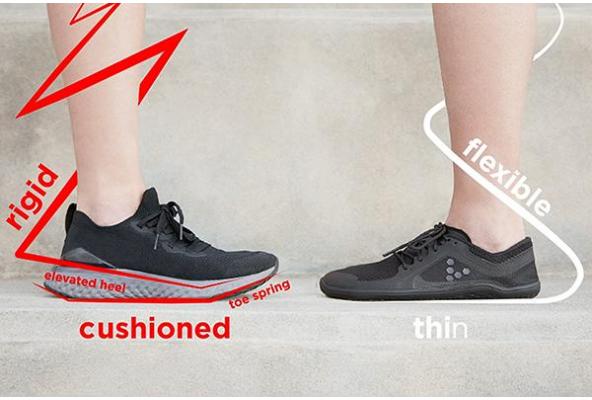In today’s modern world of fake news and extreme social norms, shoes don’t seem to be getting any more down to earth either!
It hasn’t always been that way, but take a look around (at ground level) and you will notice that it’s getting pretty normal for shoe design to be responding with some pretty abnormal shapes and sizes. Which is odd because take the shoes away and our feet are all functionally the same by design and it has been that way for 100’s of thousands of years.


Over the last few hundred years, trends in shoe design have distorted our idea of the foot. As a result, bonkers shoe shapes have become fashionable and normalised, to the detriment of our feet and ultimately healthy human movement.
The humble pointed toe shoe was originally developed to allow feet to easily slide into horse stirrups, with a heel block to stop them from sliding too far through them. Back in the day, the shape and quality of a gentleman’s boots were a pretty good indicator that his equestrian skills were up to scratch and that he had a decent ride hitched up outside.
These days not many of us commute to work on a horse and therefore you would have thought the market for stirrup friendly footwear would have disappeared long ago. This is not the case as the vast majority of the 23 billion pairs of shoes made each year have heels of some form and pointy toe shapes. If you’re reading this blog it’s likely that you’re part of the minority that along with the shape of your shoes, you’re starting to question the shape of things in general and perhaps starting to ask the question; ‘Just because it’s ‘Normal’ it doesn’t mean it’s ‘Natural’, right or good for you...
Normal adjective . conforming to a standard; usual, typical, or expected.
Natural adjective . existing in or derived from nature; not made or caused by humankind.


Phil Hoffman 1905 -After studying indigenous people*
Just like the rest of your body, your feet also adapt positively and negatively based on the environment you put them in. It’s amazing how the non-foot shaped shoe seen above has resulted in a shoe-shaped foot - you can clearly see the adaptation. It’s ridiculous to think but the shoe-shaped foot went on to influence trainer design in the early 70’s, which has left our poor western feet bent out of shape ever since.
Click HERE for further details.
But along the way there have been some pretty interesting people that this “normal” v’s “natural” shoe/foot thing didn’t go unnoticed by, notably;
1700s
Petrus Camper, the Dutch physician, anatomist, physiologist, midwife, zoologist, anthropologist, palaeontologist and a naturalist. Described shoes of his time as instruments of torture.**


Illustration from Camper’s Verhandeling. Wellcome Images L0004215.
1850’s
James Clark of Clarks shoes was following feet and not the rules with the ‘hygienic boots and shoes’ he innovated, which were ‘manufactured on anatomical principles’.
This vintage poster shows shoe shaped feet, both the conservative families v’s and the wide toe shapes of the exuberant dancing family.


Photograph: C & J Clark Ltd
1905
Phil Hoffmann - After studying indigenous people, he realised that western symmetrical shoes had a negative effect on the natural shape and function of the foot. Noting that ‘Society, apparently agrees that the human foot as formed by nature is course, vulgar and unsightly, and that its width, especially at the toes, is entirely too great. It regards the small, especially the narrow foot, as the beautiful one. The dictum of fashion has greater influence than reason’*** Highlighting that fashion rather than form has shaped the footwear industry over the last few decades.


Since Phil Hoffmann, the most notable natural foot moment came in the shape of a sneaker when the Nike ‘Free’ arrived in 2004 and as a result bought the concept of barefoot running to the mainstream. The Free was first inspired by Stanford athletes that were training barefoot on the university’s golf course. In 2002 a group of men and women examined the impact of wearing pressure-measuring insoles taped to their feet and captured their data with high speed cameras to study the foot in motion. The conclusion from Nike’s designers Tobie Hatfield (legendary Tinker Hatfield’s brother) and Eric Avar, was that the “natural” landing stride needed an unconventional natural foot shape, and a super flexible outsole that could mimic the barefoot condition.
Around the same time a young design student, a forever injured tennis player, who’s father was an Alexander Technique teacher, kept rolling his ankles over the edge of his squishy conventional running shoes while playing tennis. He put 2 and 2 together and took to his soles with a bread knife, cutting them off and replacing them with a thin layer from his tennis racket cover. After having a meeting with his cobbling shoe friend, Galahad Clark (and founder of Vivobarefoot), they went one step further, realising that the perfect shoe wasn’t just about being foot shaped, it needed a thin sole too. See your feet have the same amount of nerves in as your hands for a reason... to allow them to feel. It turns out that your feet are not just your base of support and need to flex, but they are also the ultimate movement sensors and the sensory information is key to moving naturally and injury free.
Since the early leather Vivo velcro shoes (with zip off soles in 2004!) the shoes at Vivobarefoot have come a long way, but the principles have remained the same. Your feet have all the technology you need and the shoe needs to let your feet do their natural thing.


Seems crazy doesn’t it, but one day it might just catch on.
Sources:
* https://www.tuhykorinek.cz/wp-content/uploads/2016/12/1905hoffman.pdf
** https://petruscamper.com/shoe.htm
*** https://www.tuhykorinek.cz/wp-content/uploads/2016/12/1905hoffman.pdf

